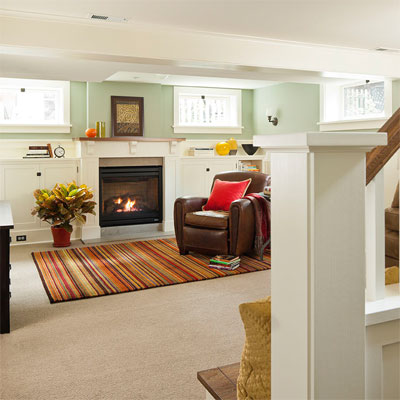
Even if it's currently cold concrete and crammed with boxes of off-season duds, the lowest floor of your home probably has loads of potential. Treat it just as you would any of the rooms aboveground, and it might just become the most popular spot in the house—for a lot less cash than adding on. Here's our bottom-line advice for turning this underutilized space into a place you'll be eager to spend time in.
The Layout Puzzle: Where To Begin
a) Put the main socializing area in a spot that gets the best natural light, to draw people in.
b) Bedrooms need a window for egress, so they'll need to be located at the perimeter.
c) The TV-viewing zone can be in a darker spot, to reduce glare and create a home-theater feel.
d) Store snacks and beverages in an area you can access without crossing in front of the TV.
What to Inspect (and Fix) Before You Start
• Test for moisture by taping 2-foot squares of plastic sheeting to the floor and walls. Wait a couple of weeks. If condensation forms underneath, your foundation's not sealed. If droplets form on top, your basement needs dehumidifying.
• Use an awl to probe for rot and insect damage in floor joists, rim and header joists, the sill plate, and wood-framed windows.
• Check floor joists for sagging by climbing a ladder until you're nearly eye level with the underside of the joists. Look across them (perpendicular to their direction) to see if any are out of line.
• Have a pro check fuel-burning equipment and your house's ventilation system to ensure that you won't have carbon monoxide buildup below grade.
Will You Need More Headroom?
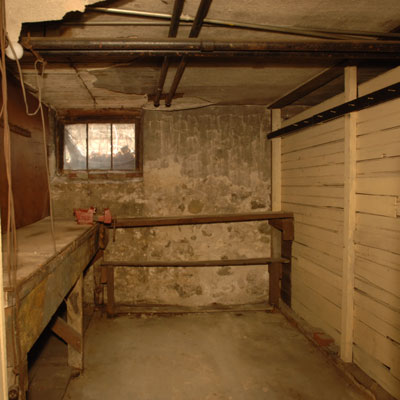
Many codes call for 7 to 7½ feet of clearance. If you don't have that height, you may be able to dig out and lower the concrete floor, but it's a complex, pricey job. Ask your contractor if moving ducts and pipes might solve the problem.
Double Up on Sump Pumps
It's best to have both a battery backup for your main pump, in case of a power outage, and a second pump, in case the first one gives out. If your house is hooked up to a municipal water supply, invest in a water-powered backup pump that's juiced by pressure in the supply line.
DIY Waterproofing
Minor leaks may not need the attention of a pro. "Often a few simple fixes will solve a moisture problem," says This Old House general contractor Tom Silva. His tips:
• Install diverters to send gutter water at least 10 feet from the foundation.
• Slope soil away from the foundation.
• Seal small cracks or gaps around pipes with concrete-patching compound.
• Fill larger cracks inside and out with hydraulic cement, which expands as it cures. A structural engineer should inspect any cracks that are wider than a pencil.
Insulate Pipes Before Boxing Them In
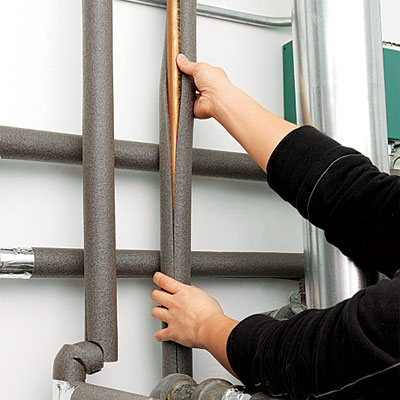
While they're exposed, slip foam insulation sleeves over hot-water pipes to prevent heat loss and over cold-water ones to prevent condensation from dripping on the inside of the drywall or ceiling.
Banish mold—ban standard drywall
It just doesn't belong below grade; mold can grow on the paper coating, and the gypsum core can crumble. Try USG's Sheetrock Brand Mold Tough Gypsum Panels or Georgia-Pacific's nonpaper-faced DensArmor Plus High-Performance Interior Panels. Both got the highest scores on a standard lab test for mold resistance.
If You Want to Add Partition Walls
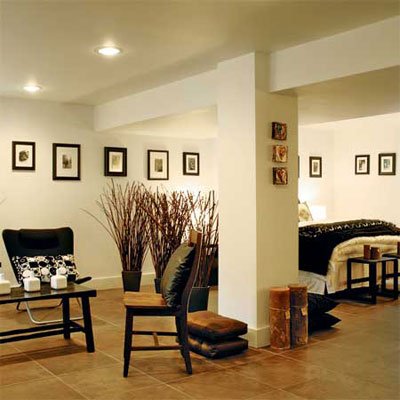
a) Put them in sparingly. Too many below-grade rooms will feel like a rabbit warren.
b) Place them between columns to turn support posts into design elements.
c) Build half-wall dividers or walls with window cutouts so that light can penetrate the interior.
d) Make them mobile. Sliding doors and movable screens can be closed for privacy as needed.
Leave Space Around Mechanicals

Whether you're moving equipment or boxing it in, heed the advice of TOH plumbing and heating expert Richard Trethewey: "Make sure a real human being can fit around mechanicals for upkeep." Plan on 2 to 3 feet of clearance.
Keep the Racket Down Below
a) To soundproof the ceiling, add fiberglass batts without a vapor barrier between the joists. Then fasten one or two layers of drywall to them, using resilient clips and metal furring channels (called hat channels, for their shape). This isolates the drywall from the joists, eliminating vibration and thus minimizing sound travel.
b) Place mechanical equipment on top of sound-dampening antivibration mats or pads.
c) Minimize connections between ducts in the basement and upper floors to reduce noise transmission.
Don't Skimp on Lighting
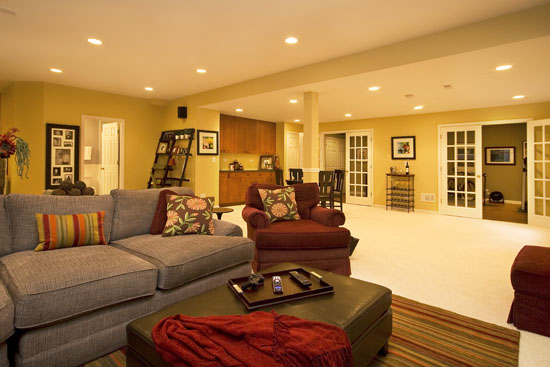
A dim basement is a real turnoff, so you'll need more fixtures than you've got elsewhere. Recessed cans broadcast light in a cone shape that's wider at
the base; if you're using them, space them closer together to avoid dark spots. A good rule of thumb: Divide the ceiling height by 2 to get the maximum distance between cans.
Better-Looking, Safer Window Wells
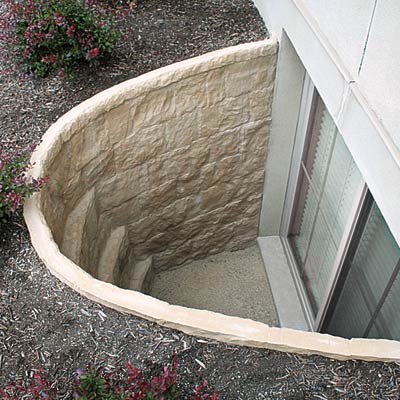 |
| RockWell's Elite Series |
Skip the corrugated metal and go for prefab wells made from fiberglass or another faux-stone material. Top them with grates or plastic covers so that people can't fall in, but make sure the toppers can be removed easily by a young child to ensure emergency egress.
Make Room for Food

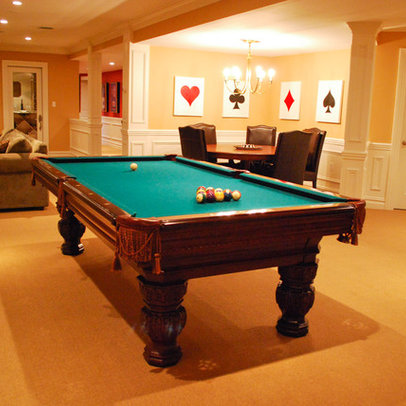
• An all-purpose worktable can seat several people for crafts, puzzles, board games, and much more—and designers say it's often a better draw for crowds than a game table.
Up the Cozy Factor
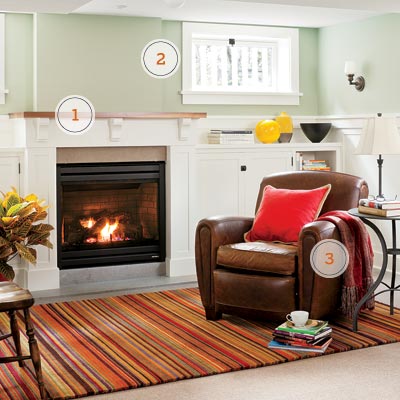
You don't need an oversized sectional to create a comfy place to curl up.
1. Put a fireplace front and center.
A direct-vent gas unit lets you avoid lugging firewood downstairs.
2. Make hopper windows less basement-like.
Built-in cabinets beneath them act as a visual anchor, making their high placement seem just right. And they gain substance and polish from crisp trim, deep sills, and bronze latch closures.
3. Use furnishings to set the tone.
A leather chair and colorful textured accessories warm up a light, airy space.
Tip: Make sure temps stay toasty.
A chilly basement will chase people away faster than you can say "brrrr." Give it a separate thermostat, and put supply registers near the floor, not the ceiling. If you need supplemental heat, try electric baseboards or radiant mats.
Tips for a Beyond-the-Basic Bedroom
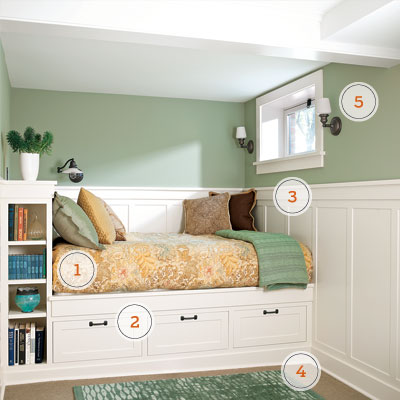
Make a narrow room (like this one, only 7½ feet wide) feel snug, not suffocating.
1. Build a spot for the bed.
Instead of aligning the full-size bed with the room's long axis, it was turned 90 degrees and tucked below the window for a perfect fit.
2. Keep storage compact.
The bookshelf doubles as a headboard and nightstand; deep drawers hold clean linens and give guests room to unpack.
3. Continue details from adjacent spaces.
Here, the wainscot ties the sleeping nook in with the rest of the rooms.
4. Layer rugs for warmth.
An area rug laid on top of rugged wall-to-wall carpet adds welcome texture and softness underfoot.
5. Add wall fixtures.
A swing-arm reading lamp saves space and directs light right where it's needed; sconces flanking the high window draw the eye upward.
If You're Adding a Bath...
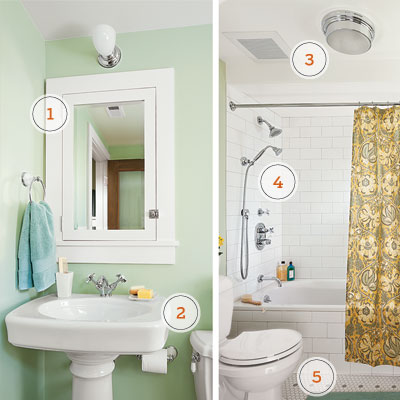
A few simple guidelines will make it functional and eye-catching.
1. Go for light-reflecting finishes.
We love this can't-fail combo of traditional white fixtures, a painted medicine cabinet, and shiny chrome hardware with porcelain accents.
2. Don't risk an overflow.
Have a plumber install a backflow-prevention valve on your main drain line to prevent backups into below-grade sinks or tubs.
3. Get rid of humid air.
Extra moisture is the last thing a basement needs. Add a humidistat to your bath's exhaust fan that will automatically turn it on when the air's too damp.
4. Minimize pipe runs.
Here, the sink, tub, and toilet share the same wall, which simplifies plumbing installation and keeps costs down.
5. Handle wastewater properly.
A full, below-grade bath needs a sewage ejector system with a tank and pump. For a half bath, consider a macerating toilet, whose compact tank can handle the sink and john.
Source: This Old House
Make Room for Food

You don't need a full kitchen. But you'll get plenty of mileage from a mini fridge for beverages, a cabinet to hold snacks, and a microwave for heating leftovers or making popcorn for movie nights. Keep a tray handy for stacking and transporting dirty dishes upstairs.
Save Space for Play

• Game tables eat up a lot of square footage. For a small pool table (3½ feet by 7 feet), you need a clear space at least 11½ feet wide by 14½ feet long to play comfortably—if you buy the shortest cues, that is. A tournament-size pool table (4½ feet by 9 feet) or a 5-by-9 Ping-Pong table needs even more room. Unless you're positive you'll use it a lot, consider skipping a single-activity table.
• An all-purpose worktable can seat several people for crafts, puzzles, board games, and much more—and designers say it's often a better draw for crowds than a game table.
• Today's video games involve actual physical activity, not just fiddling with a joystick. Check your gaming platform for recommended clearances around and above the console. (No one should break a bone playing a virtual version of any sport.)
• Wall-to-wall carpet is a good choice to deaden sound in a play area. Opt for synthetic fibers that resist mold and mildew.
Up the Cozy Factor

You don't need an oversized sectional to create a comfy place to curl up.
1. Put a fireplace front and center.
A direct-vent gas unit lets you avoid lugging firewood downstairs.
2. Make hopper windows less basement-like.
Built-in cabinets beneath them act as a visual anchor, making their high placement seem just right. And they gain substance and polish from crisp trim, deep sills, and bronze latch closures.
3. Use furnishings to set the tone.
A leather chair and colorful textured accessories warm up a light, airy space.
Tip: Make sure temps stay toasty.
A chilly basement will chase people away faster than you can say "brrrr." Give it a separate thermostat, and put supply registers near the floor, not the ceiling. If you need supplemental heat, try electric baseboards or radiant mats.
Tips for a Beyond-the-Basic Bedroom

Make a narrow room (like this one, only 7½ feet wide) feel snug, not suffocating.
1. Build a spot for the bed.
Instead of aligning the full-size bed with the room's long axis, it was turned 90 degrees and tucked below the window for a perfect fit.
2. Keep storage compact.
The bookshelf doubles as a headboard and nightstand; deep drawers hold clean linens and give guests room to unpack.
3. Continue details from adjacent spaces.
Here, the wainscot ties the sleeping nook in with the rest of the rooms.
4. Layer rugs for warmth.
An area rug laid on top of rugged wall-to-wall carpet adds welcome texture and softness underfoot.
5. Add wall fixtures.
A swing-arm reading lamp saves space and directs light right where it's needed; sconces flanking the high window draw the eye upward.
If You're Adding a Bath...

A few simple guidelines will make it functional and eye-catching.
1. Go for light-reflecting finishes.
We love this can't-fail combo of traditional white fixtures, a painted medicine cabinet, and shiny chrome hardware with porcelain accents.
2. Don't risk an overflow.
Have a plumber install a backflow-prevention valve on your main drain line to prevent backups into below-grade sinks or tubs.
3. Get rid of humid air.
Extra moisture is the last thing a basement needs. Add a humidistat to your bath's exhaust fan that will automatically turn it on when the air's too damp.
4. Minimize pipe runs.
Here, the sink, tub, and toilet share the same wall, which simplifies plumbing installation and keeps costs down.
5. Handle wastewater properly.
A full, below-grade bath needs a sewage ejector system with a tank and pump. For a half bath, consider a macerating toilet, whose compact tank can handle the sink and john.
Source: This Old House

No comments:
Post a Comment